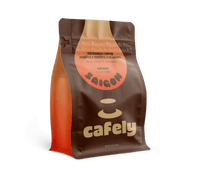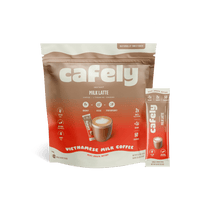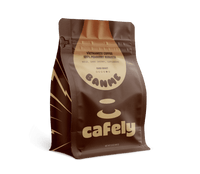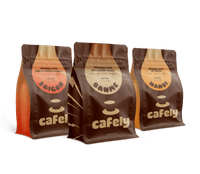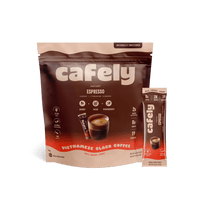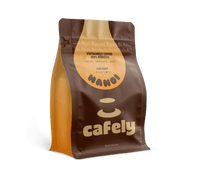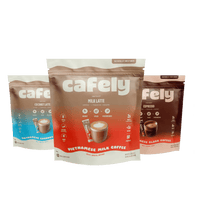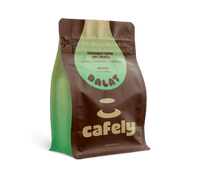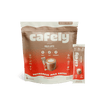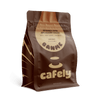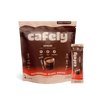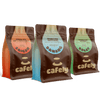The mocha combines arabica coffee with dark chocolate and milk. The result is a creamy, balanced brew with dessert-like qualities. This brew is a favorite among coffee and chocolate lovers and is the perfect indulgent beverage for cold winter days.
In this article, you’ll learn about the characteristics of mocha coffee, what it tastes like, what goes into it, how to make it, and when and where it was invented.
What is Mocha Coffee?
Mocha coffee is a brew that combines the dark, bitter flavors of coffee with the sweetness of chocolate.
Here's what's inside and how it tastes:
What’s Inside a Mocha Coffee?

The basis of the mocha coffee is chocolate, coffee, and milk. Espresso is typically used for its strong, robust flavor, and dark chocolate is used for its complex, rich sweetness.
These ingredients build a traditional mocha coffee:
- Arabica coffee
- Dark chocolate (75% cocoa+)
- Whole milk
- Whipped cream (optional)
- Sugar or syrup (optional)
What Does Mocha Coffee Taste Like?
Mocha coffee is a delicious blend of rich chocolate and coffee combined with milk and (often) cream. This beverage offers a smooth, sweet, creamy flavor profile with nutty, chocolatey notes.
The defining taste of the mocha coffee comes from chocolate — the flavor notes can range from dark and rich to sweet and creamy. The coffee base (usually espresso) provides a bold, robust, roast flavor. These two elements create a balanced, smooth brew that's not overly bitter or sweet.
Mocha coffee is made using steamed or frothed milk, offering a creaminess that softens the rich flavors of chocolate and coffee. The milk brings the flavors of these two elements together to create an indulgent, dessert-like coffee.
The Origins of the Mocha Coffee
The origins of the mocha coffee trace back to the port city of Al-Mokha in Yemen.
Here’s how the Arabian port may have inspired the mocha coffee we know today:
1. The “Original” Mocha Coffee
The city of Mokha is a historic center for coffee trade from the 15th to 18th century. Located on the Red Sea, Mokha became world-renowned for its unique coffee beans, which had a rich, chocolatey flavor profile.
The beans — mostly grown in central Yemen — were harvested, roasted, and transported to Mokha where they could be shipped across the globe. The coffee beans from Mokha were of the arabica variety and were famed for their natural chocolate-like flavor.
Yemen is still a key coffee producer — exporting between 7000 and 10000 tons of coffee per year — but production levels are low compared to South America and Asia.
2. How Mokha Inspired the Mocha
It’s believed that the chocolatey arabica beans from Mokha inspired Europeans to experiment by blending coffee with cocoa. This happened sometime in the early 17th century.
By the late 17th century, coffee houses in Europe began serving variations of coffee mixed with chocolate, sugar, and milk — catering to the adapting palate of the West.
Today, the term “mocha” refers to any beverage that combines chocolate and coffee. However, the “traditional” mocha utilizes arabica beans — perhaps an ode to its Yemeni roots.
3. The Birth of the Espresso-Based Mocha
It’s difficult to trace when and where the chocolate and coffee combination evolved into the espresso-based beverage we know as mocha today. However, it was likely created somewhere in Europe during the early to mid-20th century when the espresso machine was developed.
After WW2, espresso machines became commonplace in Europe. Cafes and coffee houses began experimenting with espresso and milk to create a variety of beverages we love today.
The mocha as we know it was likely invented alongside other milky espresso-based beverages like the cafe latte, cappuccino, and macchiato coffee.
What Do You Need to Make Mocha Coffee?
Making the perfect mocha coffee at home isn't a difficult process. However, there are some tools and ingredients that are essential:
Ingredients
- Arabica coffee — A dark roast arabica coffee is best for a traditional mocha. If you prefer a more robust brew, opt for an arabica and robusta blend.
- Filtered water — Pure, filtered water brews the best espresso shot for mocha coffee.
- Whole milk — High-fat whole milk produces the creaminess a mocha coffee needs. Opt for oat milk or almond milk for a vegan mocha.
- Dark chocolate or cocoa powder — A high-quality dark chocolate with 75%+ cocoa or cocoa powder is best for mocha coffee.
- Sugar or syrup (optional) — Sugar or syrup can be used to sweeten your mocha. Try vanilla syrup if you want to spruce up your coffee.
- Whipped cream (optional) — Mocha coffee is typically topped with a dollop of freshly whipped cream.
Equipment
- Coffee grinder — Freshly ground coffee produces the best mocha. A burr grinder produces the best consistency for the espresso or moka pot brewing methods.
- Coffee machine — The Best mocha is made using an espresso machine. However, you can use a moka pot, Aeropress, pour-over, or drip coffee maker if you don't have one.
- Coffee measure — You'll need a coffee measure if you want to create the perfect mocha consistently.
- Large coffee mug — Mocha coffee is best served in a large coffee mug or heat-proof glass.
- Stirring spoon — You'll need a metal spoon to mix ingredients.
- Stovetop pan — A small pan will be used to heat the milk.
- Small mixing bowl — This will be used to make the chocolate syrup.
- Fine whisk or milk frother — Used to combine the ingredients and produce a velvety texture.
The Best Coffee for Mocha

The traditional coffee for mocha is arabica. Its smooth, naturally sweet flavor and nutty, fruity undertones balance perfectly with chocolate. A dark roast arabica coffee such as Cafely DaLat (100% Arabica) is ideal for making traditional mocha coffee.
If you prefer a more robust brew and want the flavors of coffee to shine through the chocolatey creaminess of the mocha, an arabica and robusta blend is a good option.
A blend such as Cafely Saigon OG makes the perfect cup of mocha coffee. The dark, bitter, robust flavors or robusta paired with the sweet smoothness of arabica work wonders when matched with chocolate and milk.
If you want to make the best possible mocha, the freshness of the coffee is perhaps more important than the type. Whether you choose a robusta coffee, arabica, or blend, make sure to opt for a fresh, whole bean. Grinding the coffee just before brewing produces a shot with maximum flavor and charisma.
How to Make Mocha Coffee: Step-by-Step
Making a mocha coffee is a simple and relatively quick process. However, it takes a bit more work and finesse than your typical cup of Joe.
Here's how to make the perfect mocha step-by-step:
1. Measure and Grind the Coffee
First, measure and grind your coffee. The amount and grind size you need will depend on the brewing method.
If you're using espresso (recommended), opt for nine grams for a single shot or 18 grams for a double shot. Grind the coffee fine — a consistency similar to powdered sugar.
2. Brew the Espresso Shot
Next, brew a shot of espresso or a strong black coffee if you're using an alternative brewing method.
To make an espresso, heat the machine and fill the water reservoir with clean, filtered water. Fill the portafilter with ground coffee, tamp, and connect it to the group head on your machine. Brew a quality shot of espresso (25 to 30 seconds).
3. Heat the Milk
In a pan, gently heat around 200 mL of whole milk or a dairy-free alternative, making sure not to boil it.
4. Prepare the Chocolate Syrup
In a small mixing bowl, add your dark chocolate or cocoa powder. Pour in a small amount of freshly boiled water and stir to melt and combine.
Add sugar or syrup at this stage if you wish to sweeten your mocha coffee.
5. Combine the Milk and Syrup
Combine the chocolate syrup and warmed milk. Use a milk frother or fine whisk to combine the ingredients and produce a light, velvety texture.
6. Assemble the Mocha
Pour the espresso shot into a large mug, followed by the chocolate milk. Lightly stir to combine the two.
7. Garnish and Serve
Optional: Add a dollop of freshly whipped cream (or squirty cream from a can) and garnish with coffee beans and a dusting of chocolate flakes or powder.
Serve the mocha coffee and enjoy it while warm.
FAQs: What is Mocha Coffee?
Want to learn more about mocha and other unique coffee formats?
Head over to the Cafley Blog and read the answers to the frequently asked questions below:
1. Do You Have to Use Espresso for Mocha Coffee?
Mocha coffee is traditionally made with espresso. However, you can use any strong, dark brew. Moka pot coffee is the next best option; otherwise, Aeropress brewer, drip coffee, French press, or pour-over brews work.
2. Can You Make Iced Mocha Coffee?

Yes. You can make delicious iced mocha coffee by cooling down the chocolate milk and coffee shot, combining, and pouring over ice. Iced mocha coffee is the perfect brew for chocolate lovers when the sun is shining, and a regular brew is too hot to handle.
3. What’s the Best Coffee for Mocha?
Dark roast arabica coffee is typically used to make mocha coffee. However, robusta and blends can be used to increase the intensity of the coffee. We recommend Cafely DaLat (100% Arabica) for a traditional mocha, the Hanoi Coffee (100% Robusta) for a darker mocha, or the Saigon OG Blend for a balanced mocha.
4. What’s the Difference Between Arabica and Robusta?
Arabica and robusta are two types of coffee beans. Arabica beans are more popular in the West. They produce a smooth, naturally-sweet coffee with a mild caffeine hit. Robusta produces a dark, nutty brew that's twice as strong and much more bitter compared to arabica.
5. Where is Mocha Coffee From?
The mocha can be traced back to the 15th century in Yemen. However, the origins of the sweet, creamy, chocolatey beverage we know today are unclear.
6. How Much Caffeine is in a Cup of Mocha Coffee?
There’s 90 to 120 mg of caffeine in a standard 240 mL (8 oz.) Cup of mocha coffee. However, the strength of the brew can vary depending on the bean type used, the number of espresso shots, and how much caffeine in the chocolate used in the coffee.
7. Can You Add Vanilla Syrup to Mocha Coffee?
Yes. You can add vanilla syrup to mocha coffee. The sweet, tropical flavors of vanilla pair wonderfully with the nutty, floral coffee flavors and dark chocolatey notes. Adding vanilla syrup to mocha coffee is a great way to spice up your daily brew.
8. What’s the Fastest Way to Make Mocha Coffee?
The quickest way to make a mocha coffee is to use a strong instant coffee such as Cafely Vietnamese Instant Espresso, cacao powder, and milk. This will create a strong coffee with a chocolatey taste. However, nothing beats a genuine mocha crafted with espresso using the recipe above.
9. Is Mocha Coffee Vegan-Friendly?
No. Regular mocha coffee isn't vegan-friendly. Whole cow's milk is used to create this chocolatey brew. However, if you're making mocha at home, you can swap out cow's milk for a dairy-free, vegan alternative such as coconut milk, almond milk, or oat milk.
10. What Country Drinks the Most Coffee?
Finland drinks the most coffee per capita. The average Finn consumes 12 kilograms (26.5 lb) per year. Compared to the United States, where the average person consumes 4.2 kg (9.26 lb) per year, that's a lot of coffee.
